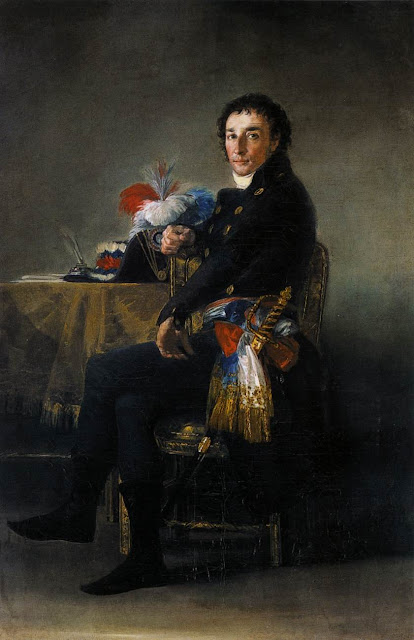Giambattista Tiepolo (1696-1770) left Italy from 1750 to 1753 and stayed in Germany painting ceilings at Würzburg for Prince-Bishop Elector Karl Philipp von Greiffenclau – to complement other decorations in the Prince-Bishop's new-built palace.
The central oval panel between the two round windows above (and in detail below) represents the wedding ceremony of Frederick Barbarossa and Beatrice of Burgundy. According to historians this event occurred in the 12th century. According to Teipolo it occurred beyond time, in a sort of luscious European eternity.
 |
| Giambattista Tiepolo Marriage of Frederick Barbarossa and Beatrice of Burgundy 1751 fresco Kaisersaal, Würzburg |
"He was not tall, unobtrusive, but he held your attention with his feverish silence, his dark cheer, his alternately arrogant and oblique manner – grim, as they said. At least that was how he was seen later in life. None of that appears on the Würzburg ceilings, on the south wall of the Kaisersaal to be precise, in the wedding procession of Frederick Barbarossa, in the portrait Tiepolo left of him, when the model was twenty years old: he is there, so they say, and you can go see him, perched among a hundred princes, a hundred constables and ushers, as many slaves and merchants, porters, putti and animals, gods, merchandise, clouds, the four seasons and the four continents, and two incontestable painters, the ones who assembled the world that way in its exhaustive recension and are nevertheless of the world, Giambattista Tiepolo himself and Giandomenico Tiepolo, his son. So he is there as well, tradition has it that he is there, and that he is the page who bears the crown of the Holy Empire on a gold-tasseled cushion; you can see his hand under the cushion, his slightly tilted face is looking down toward the ground; his whole bent torso seems to accompany the weight of the crown: tenderly, suavely he gives way under the Empire."
"He was handsome and insolent, loved, hated, he was one of those ambitious young men who have nothing to lose, who risk all, so enamored of the future that they seem to mirror the futureof anyone who encounters them: and the men without futures detest him, and the others, no. A thousand novels were written about him, about the men amazed by him, about the women’s taste for him and his taste for them; we know the story of his skirmish with the princebishop over a girl, the chase in the great staircase, Tiepolo’s laughter above; we can almost hear that supernatural laugh of the magician; we begin to think it is all for him, the blond boy, all these haughty, easy women thrown onto the ceilings: so much so that in the fresco where the page appears, or legend has him appear, we sometimes have the impression (we want to have the impression) that ten steps in front of him the beautiful Beatrice of Burgundy kneeling beside her master the handsome Barbarossa directly below the cross, the miter, the glove of the prince-bishop who is marrying them, that Beatrice will next turn to him, rise, and with all her fair flesh and blue brocade walk toward him and, overturning the crown, embrace him."
– quoted passages are from The Eleven, translated from Les Onze by Pierre Michon. It is a novel about an imaginary painter producing a masterpiece at the start of the French Revolutionary Terror. The book appeared in French in 2009 and won the Grand prix du roman that year. Jody Gladding and Elizabeth Deshays made the English translation, published in 2013.
The paperback cover of the French edition (above) used a detail from Francisco Goya's portrait (below) of Ferdinand Guillemardet, French Republican ambassador to Spain, painted in 1798. It hangs at present in the Louvre, where the novel's imaginary masterpiece (a group portrait of eleven men – more or less like Guillemardet – who managed to put themselves in charge of the Terror) is supposed to occupy the place of honor, having eclipsed the Mona Lisa.
Ferdinand Guillemardet was (not only in fiction, but in life) one of those who had voted for the execution of Louis XVI and Marie Antoinette five years earlier. For his portrait he wore what Michon describes as "... the extravagant tricolored silk waistband, silk an inch thick ..."
 |
| Pierre Michon |







